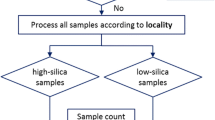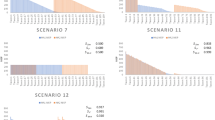Abstract
The ability of association analysis to discriminate sedimentary facies was tested on Purdy's modal analyses of modern sediments of the Great Bahama Bank. Purdy's data set has served in the past as a standard reference for evaluating various multivariate classification algorithms. In order to adapt Purdy's data to association analysis, the percent abundance of the 12 constituents was converted to binary form by dichotomizing each variable on its mean value. The results obtained by association analysis are virtually identical to those obtained by Purdy and other authors. The same four main sedimentary facies were discriminated; 86% of the samples were identically classified (97% when misclassified borderline cases are counted as matches); the total partition variance of the classification is only negligibly greater (4%); and the grouping of the variables yielded the same four groups. The rank order of the three division-attributes responsible for the sample classification is fines, oolites, and corals. Association analysis has been employed by other authors to differentiate meaningful facies groups in studies of ancient reef carbonates, modern reef sediments, and heavy minerals in stream sediments. In all these studies, the results were found to be compatible with those obtained by using the continuous quantitative measurements, indicating that qualitative binary data may often be sufficient for the purpose of facies discrimination in many branches of geology and that association analysis is an effective method for this purpose.
Similar content being viewed by others
References
Ayalon, A., Bar-Mathews, M., and Nathan, Y., 1981, Geochemistry of Stream Sediments Along the Western Coast of the Gulf of Elat (Aqaba): J. Geochem. Explor., v. 15, p. 393–404.
Bonham-Carter, G. F., 1965, A Numerical Method of Classification Using Qualitative and Semi-Quantitative Data, as Applied to the Facies Analysis of Limestones: Bull. Can. Petrol. Geol., v. 13, p. 482–502.
Bonham-Carter, G. F., 1967, An Example of the Analysis of Semi-Quantitative Petrographic Data: Proc. 7th World Petroleum Congress, v. 2, p. 567–583.
Buchbinder, B., 1979, Facies and Environments of Miocene Reef Limestones in Israel: J. Sediment. Geol., v. 49, p. 1323–1344.
Buchbinder, B., and Gill, G., 1976, Numerical Classification of Multivariate Petrographic Presence-Absence Data by Association Analysis in the Study of the Miocene Ziqlag Reef Complex of Israel,in D. F. Merriam (Ed.), Quantitative Techniques for the Analysis of Sediments: Pergamon Press, Oxford, p. 23–31.
Buchbinder, B., 1979. Facies and Environments of Miocene Reef Limestones in Israel: J. Sediment. Geol., v. 49, p. 1323–1344.
Buzas, M. A., 1967. An Application of Canonical Analysis as a Method for Comparing Faunal Areas: J. Anim. Ecol., v. 36, p. 563–577.
Buzas, M. A., 1972, Biofacies Analysis of Presence or Absence Data Through Canonical Variate Analysis: J. Paleontol., v. 46, p. 55–57.
Doveton, J. H., Bullard, D. W., and Harvey, P. K., 1974. Latent Class Analysis of Gold Concentration Anomalies,in T. B. Johnson and D. W. Gentry (Eds.), Proc. 12th Symposium on the Application of Computers and Mathematics in the Mineral Industry: Colorado School of Mines, v. 1, p. D28–D40.
Eckdale, A. A., Eckdale, S. F., and Wilson, J. L., 1976, Numerical Analysis of Carbonate Microfacies in the Cupido Limestone (Neocomian-Aptian), Coahuila, Mexico: J. Sediment. Petrol., v. 46, p. 362–368.
Erez, Y., 1972, Multivariate Analysis of Biogenic Constituents in the Sediments off Ras Burka, Gulf of Eilat: Unpublished M.Sc. thesis, Hebrew University of Jerusalem (in Hebrew), 58 p.
Erez, Y., and Gill D., 1976, Multivariate Analysis of Biogenic Constituents in Recent Sediments Off Ras Burka, Gulf of Elat: J. Math. Geol., v. 8, n. 6, p. 77–98.
Gill, D., and Tipper, J. C., 1978, The Adequacy of Non-metric Data in Geology: Tests Using a Divisive-Omnithetic Clustering Technique: J. Geol., v. 86, p. 241–259.
Gill, D., Boehm, S., and Erez, Y., 1976, ASSOCA: FORTRAN IV Program for Williams and Lambert Association Analysis with Printed Dendrograms: Comput. Geosci., v. 2, n. 2, p. 219–247.
Imbrie, J., and Purdy, E. G., 1962, Classification of Modern Bahamian Carbonate Sediments,in W. E. Ham (Ed.), Classification of Carbonate Rocks: AAPG Mem. 1, Tulsa, p. 253–272.
Kaesler, R. L., 1966, Quantitative Re-evaluation of Ecology and Distribution of Recent Foraminifera and Ostracoda of Todos Santos Bay, Baja California, Mexico: University of Kansas Paleont. Contr., Paper 10, 50 p.
Klovan, J. E., 1964, Facies Analysis of the Redwater Reef Complex, Alberta, Canada: Bull. Can. Petrol. Geol., v. 12, p. 1–100.
Lambert, J. M., 1972, Theoretical Models for Large-Scale Vegetation Survey,in J. N. R. Jeffers (Ed.), Mathematical Models in Ecology, 12th Symp.: British Ecological Soc., Blackwell Scientific Publ., Oxford, p. 87–109.
Lambert, J. M., and Williams, W. T., 1962, Multivariate Methods in Plant Ecology. IV. Nodal Analysis: J. Ecol., v. 50, p. 775–802.
Lance, G. N., and Williams, W. T., 1965, Computer Programs for Monothetic Classification (“Association Analysis”): Comput. J., v. 8, n. 3, p. 246–249.
Macnaughton-Smith, P., 1965, Some Statistical and Other Numerical Techniques for Clustering Individuals: Home Office Studies in the Cause of Delinquency and Treatment of Offenders, H.M.S.O. Home Office Research Unit Rept. No. 6, London, 33 p.
Macnaughton-Smith, P., Williams, W. T., Dale, M. B., and Mockett, L. G., 1964, Dissimilarity Analysis: A New Technique of Hierarchical Subdivision: Nature, v. 202, n. 4936, p. 1034–1035.
Maddocks, R. F., 1966, Distribution Patterns of Living and Subfossil Podocopid Ostracodes in the Nosy Be Area, Northern Madagaskar: Univ. of Kansas Paleont. Contr. Paper 12, 72 p.
McCammon, R. B., 1968, Multiple Component Analysis and Its Application in Classification of Environments: AAPG Bull., v. 52, p. 2178–2196.
Mello, J. F., and Buzas, M. A., 1968, An Application of Cluster Analysis as a Method of Determining Biofacies: J. Paleontol., v. 42, p. 747–758.
Parks, J. M., 1966, Cluster Analysis Applied to Multivariate Geologic Data: J. Geol., v. 74, p. 703–715.
Parks, J. M., 1969, Multivariate Facies Maps,in D. F. Merriam (Ed.), Symposium on Computer Applications in Petroleum Exploration: Kansas Geol. Surv. Computer Contribution, No. 40, p. 6–12.
Purdy, E. G., 1960, Recent Calcium Carbonate Facies of the Great Bahama Bank: Unpublished Ph.D. thesis, Columbia Univ., 174 p.
Purdy, E. G., 1963a, Recent Calcium Carbonate Facies of the Great Bahama Bank. 1. Petrography and Reaction Groups: J. Geol., v. 71, p. 334–355.
Purdy, E. G., 1963b, Recent Calcium Carbonate Facies of the Great Bahama Bank. 2. Sedimentary Facies: J. Geol., v. 71, p. 472–497.
Ramsayer, G. R., and Bonham-Carter, G. F., 1974, Numerical Classification of Geologic Patterns Characterized by Binary Variables: J. Math. Geol., v. 6, p. 59–72.
Tipper, J. C., 1974, The Marine Silurian of the North Esk Inlier: Unpublished Ph.D. thesis, University of Edinburgh, 211 p.
Tipper, J. C., 1975, Lower Silurian Animal Communities—Three Case Histories: Lethaia, v. 8, p. 287–299.
Tipper, J. C., 1979, An Algol Program for Dissimilarity Analysis: A Divisive-Omnithetic Clustering Technique: Comput. Geosci., v. 5, p. 1–13.
Warshauer, S. M., and Smosna, R., 1977. Paleontologic Controls of the Ostracode Communities in the Tonoloway Limestone (Silurian; Pridoli) of the Central Appalachians,in H. Hoffer and D. Danielopol (Eds.). Aspects of Ecology and Zoogeography of Recent and Fossil Ostracoda, W. Junk b.v. Publishers, The Hague, p. 475–485.
Williams, W. T., 1971, Principles of Clustering: Annu. Rev. Ecol. Systemat., v. 2, p. 303–326.
Williams, W. T., and Lambert, J. M., 1959, Multivariate Methods in Plant Ecology. I. Association-Analysis in Plant Communities: J. Ecol., v. 47, p. 83–101.
Williams, W. T., and Lambert, J. M., 1960, Multivariate Methods in Plant Ecology. II. The Use of an Electronic Digital Computer for Association-Analysis: J. Ecol. v. 48, p. 689–710.
Williams, W. T., and Lambert, J. M., 1961, Multivariate Methods in Plant Ecology. III. Inverse Association-Analysis: J. Ecol., v. 49, p. 717–729.
Author information
Authors and Affiliations
Rights and permissions
About this article
Cite this article
Gill, D. Discrimination of sedimentary facies by association analysis. Math Geol 25, 471–482 (1993). https://doi.org/10.1007/BF00894780
Received:
Accepted:
Issue Date:
DOI: https://doi.org/10.1007/BF00894780




